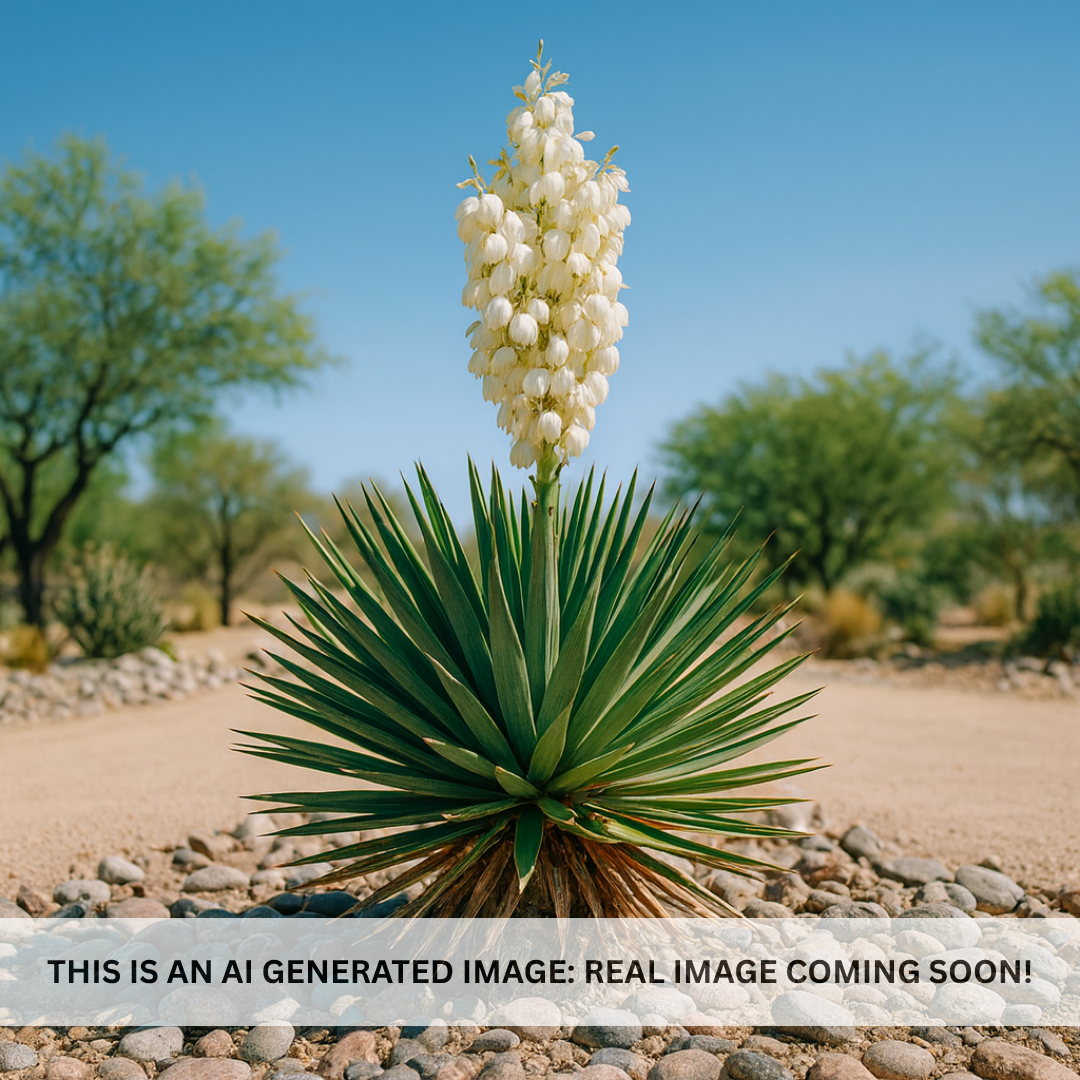My Store
Adam's needle
Adam's needle
Couldn't load pickup availability
Plant Type: perennial, evergreen succulent (stemless yucca)**
Plant Height: 2–3 feet (flower stalks up to 6 feet)**
Spread: 3–5 feet
Flower Color: creamy white (fragrant bell-shaped clusters)**
Sun Exposure: Full sun to light partial sun
Adam’s Needle / Yucca filamentosa: A Classic, Low-Growing Yucca with Graceful Form and Exceptional Hardiness
Yucca filamentosa, commonly known as Adam’s Needle, is one of the most ornamental and cold-hardy yucca species, prized for its soft arching leaves, filament-like leaf edges, and stunning flower spikes. Native to the southeastern United States, this species thrives in both arid and temperate climates, making it an ideal choice for Arizona landscapes where structure, texture, and low maintenance are key.
Unlike taller tree-form yuccas, Y. filamentosa grows as a stemless rosette, forming elegant mounds of blue-green foliage and sending up tall, candle-like flower spikes each summer.
Key Features of Yucca filamentosa
Adam’s Needle forms a dense rosette of long, sword-shaped leaves that are blue-green to gray-green in color, typically 2–3 feet long and tapering to a soft point. Along the edges of each leaf, delicate white fibers (filaments) naturally curl and twist—giving the plant its name and adding unique texture and movement.
In late spring through summer, mature plants produce tall flower stalks reaching up to 6 feet high, topped with large, creamy white, bell-shaped blooms that dangle gracefully in clusters. The flowers are fragrant and attract pollinators such as moths and hummingbirds.
After flowering, the plant may produce small offsets or “pups” around the base, slowly forming a tidy clump that expands with time. Its compact, non-invasive nature makes it a perfect fit for borders, rock gardens, and entryway plantings.
Growing and Care Tips
Yucca filamentosa thrives in full sun but tolerates light partial shade, especially in the extreme summer heat of Arizona. It prefers sandy, rocky, or decomposed granite soil with excellent drainage and performs well even in nutrient-poor conditions.
Water deeply but infrequently during establishment—every 10–14 days depending on temperature and soil drainage. Once established, water only every 4–6 weeks in summer if there’s no rainfall. Overwatering can cause root rot or crown softness.
This yucca is extremely hardy, tolerating temperatures from 0°F up to 110°F, making it suitable for both low and high desert climates. It’s also highly resistant to drought, wind, and deer.
Minimal maintenance is needed—remove spent flower stalks once dry and trim older leaves near the base for a tidy appearance. Wear gloves when pruning; while the leaf tips are not razor-sharp like Yucca aloifolia, they can still be firm and fibrous.
Landscaping Uses
The Adam’s Needle is an excellent accent plant or border species in both modern and traditional desert gardens. Its clean rosette form and soft blue-green color pair beautifully with agaves, aloes, and ornamental grasses, as well as with rock or gravel backdrops.
Use it as a focal point in smaller beds, a foundation plant near entryways, or a low barrier plant along walkways or driveways. When in bloom, its tall, candle-like flower stalks create a dramatic vertical contrast to the rounded or spiky forms of other succulents.
It also performs beautifully in container plantings and mixed succulent arrangements, where its foliage and blooms provide structure year-round.
Summary
The Adam’s Needle (Yucca filamentosa) is a timeless desert plant—compact, elegant, and incredibly resilient. With its ribbon-like filaments, soft blue-green leaves, and showy white blooms, it adds year-round structure and summer drama to Arizona landscapes. Perfect for homeowners seeking a hardy, waterwise accent plant with graceful form and minimal upkeep, Adam’s Needle is a symbol of enduring desert beauty and strength.
Three Timbers Installation Guide (Feel Free to Follow):
Yucca filamentosa Planting Guide:
Location: Full sun to light partial sun; ideal in bright, open sites with at least 6 hours of direct light daily. Handles reflected heat once established.
Soil: Use sharply draining soil composed of cactus mix, sand, and decomposed granite. Avoid clay-heavy or moisture-retentive soils.
Spacing: Allow 3–5 feet between plants or nearby structures to accommodate mature spread and airflow.
Planting Depth: Keep the root crown level with or slightly above soil grade. Do not bury the center of the rosette.
Support: None required; forms a naturally sturdy, self-supporting structure.
Watering Guide:
Watering After Planting: Water deeply once after installation to settle the soil. Then allow it to dry fully before watering again. During the first 3–4 months, water every 10–14 days depending on heat and drainage.
When is the Plant Established? Yucca filamentosa is considered established after 6–9 months, once new growth appears and leaves thicken to a firm, upright texture.
Watering Once Established: Water every 4–6 weeks in summer if no rainfall occurs. In winter, water only during prolonged drought.
Drip Irrigation Setup: Install one low-flow emitter (0.5–1 gallon per hour) about 8–12 inches from the base, angled outward. Run sparingly and allow full drying between cycles.
General Watering Tips: Always confirm soil dryness before watering again. Overwatering can cause crown rot. A top dressing of decomposed granite or gravel enhances drainage, stabilizes soil temperature, and highlights the yucca’s fine leaf texture. Keep rock several inches from the base for airflow and long-term plant health.
Share












